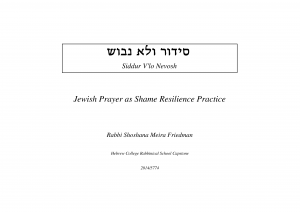In a beloved teaching, Rabbi Menachum Nachum Twersky (1730-1787), the Me’Or ‘Enayim, asks us to reflect on God’s presence in all the world when we are in a “deeply fallen state:”[1] Rabbi Menachum Nachum Twersky (1730-1787) was the founder of the Chernobyl Ḥasidic dynasty. His work the Me’Or ‘Enayim is one of the foundational works of Ḥasidism. This selection comes from his commentary on parashat Yitro, Exodus 24:7. I have used the translation from Speaking Torah, by Art Green, Ebn Leader, Ariel Evan Mayse, and Or Rose (Jewish Lights, Woodstock, 2013). “But how can you come to YHVH when you are in such a fallen state?” he teaches. “Your very awareness and your mental powers have been taken away from you!” What a wonderful description of what Brown calls a shame attack – the ringing in our ears, the flush on our cheeks, the mad desire to crawl into a hole or out of our own skin all certainly diminish our awareness and mental powers. The Me’Or ‘Enayim continues: “Nevertheless, you come to know that ‘the whole earth is filled with God’s glory’ (Isaiah 6:3)… YHVH is called ‘the Life of life,’ meaning that the vitality of all life in the world, including that of beasts, cattle, birds, and humans, is God’s own Self, the Life of life. God is the life-force within all that lives.” Then he gives us the best shame resilience one-liner I have yet to find: “When you are in that fallen state, think of this: Am I not alive? And who is this life-force within me? Is it not the blessed Creator?”
For those of us who speak a religious language, we can understand our journey of building shame resilience as one of the many ways we can uplift, exalt, praise, and honor not just our own lives but the Life of life itself. Whenever we feel unworthy of love and belonging, we can remember that the very self which we are struggling to believe is lovable is none other a manifestation of God’s own Self. Our belief that we are worthy to live and belong is one way we can practice our trust in God. And if the God language doesn’t do it for us, we can get in touch with our own wonder at being alive, call it whatever name or conjure whatever image works for us, and remember that our journey to live a wholehearted life honors that wonder. Ultimately we can affirm that any step toward a wholehearted life lifts up holiness in this world.
The full essay accompanying Rabbi Friedman’s siddur is available at her website, here.

Index of Prayers
Notes
| 1 | Rabbi Menachum Nachum Twersky (1730-1787) was the founder of the Chernobyl Ḥasidic dynasty. His work the Me’Or ‘Enayim is one of the foundational works of Ḥasidism. This selection comes from his commentary on parashat Yitro, Exodus 24:7. I have used the translation from Speaking Torah, by Art Green, Ebn Leader, Ariel Evan Mayse, and Or Rose (Jewish Lights, Woodstock, 2013). |
|---|

“📖 סידור ולא נבוש | Jewish Prayer as Shame Resilience Practice: Siddur v’Lo Nevosh for Shaḥarit by Rabbi Shoshana Friedman” is shared through the Open Siddur Project with a Creative Commons Attribution-ShareAlike 4.0 International copyleft license.




Leave a Reply